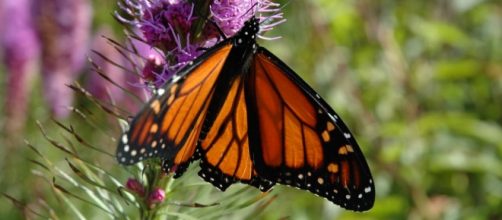Butterfly description
The monarch butterfly is a migratory insect of the family Nymphalidae which feeds mainly on milkweed. This insect is easily recognized by its orange, white and black hues, which are characteristic on its wings. When fully grown, as adults, their wings reach an approximate wingspan of 9-10.3 cm (3.5-4 inches).The monarch has six legs; however, it only utilizes its middle legs and hind legs, as the other legs; forelegs, are vestigial. The males are larger than females and possess a black spot on each hindwing.
The upper sides of the wings are from a reddish to orange tinge and the margins and veins are black with tiny white spots in them.
The undersides of the wings are of a clearer orange hue and the white spots on the veins are bigger.
Distribution
Although the monarch butterfly is mainly found in continental North America, it can also be found in parts of South and Central America and the Caribbean, as well as further west of the US, in Hawaii, the Philippines, and Australia, but also in Southern Europe, Africa and Asia. On rare occasions, it may appear in some areas of the UK, probably attracted by warm and sunny weather.
While the North American populations are known to migrate long distances in early fall of each year, other populations spread around the world only migrate smaller distances. Their wingspan may differ, with those travelling longer distances having bigger forewings than those that migrate smaller distances.
Lifecycle
The monarch butterfly undergoes complete metamorphosis in four stages; first, it starts as an egg, then it goes into larva (caterpillar) stage, following a pupa (chrysalis) stage and lastly, it becomes an adult insect. The whole transformation from egg to adult takes around 30 days.
Normally, eggs are laid under the leaves of milkweed during Spring and Summer. The number of eggs that a female lays on milkweed varies from a few hundred to more than one thousand. Eggs usually take from 3-5 days to develop into the next stage (caterpillar or larva). Migrant females may lay eggs on milkweed along the route.
The caterpillar or larva experiences five different stages, over a period of 10 to 14 days, known as instar.
On each stage, the caterpillar changes its previous skin and becomes larger due to the energy stored. After spending from 9-10 days as a chrysalis or pupa stage, the butterfly emerges and becomes an adult butterfly.
Migration
In North America, the population of butterflies east of the continental US, migrate to central Mexico and the population in the western part of the US travels to varied regions of central and southern California. Not all migrating butterflies land in Mexico, as some have been seen farther south.
Eastern monarch migrate each autumn to Mexico where they overwinter in dense clusters in oyamel fir trees. Surviving monarchs travel north in spring, mating and feeding and laying eggs in fields of milkweed along their way.
The new born butterflies continue moving north and so do the next three of four new generations.
They will usually reach as far north as Canada, where adequate feeding and breeding grounds are found. Once the weather begins to become harsher, which is usually in autumn, they will start moving farther south. The last generation of monarchs born during the last days of summer is usually the one that will do the long travel back to Mexico and remain there overwintering.
Guinness Book of World Records
A single monarch butterfly may travel as long as 5,000 km (3,100 miles) on its way south and back north on a single migration trip. It'snot really known how the monarch is able to travel such a big distance; however, it is thought that they might make use of warm fronts of air and use the prevailing winds toward the south to ease the flight.
The bright colors displayed of these insects during the larva and adulthood are good enough to warn predators about the distasteful and venomous nature of the monarch.

